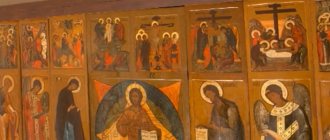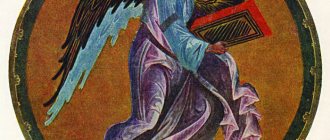Audio version of the article
- Books on the history of Byzantium
- Crossword "Byzantium"
- A series of conversations “About Byzantium” by V.L. Makhnach
***
Byzantium - (Eastern part of the Roman Empire, Byzantine Empire), a state that existed from the 4th century. to 1453, formed during the collapse of the Roman Empire into two parts: eastern and western.
***
When was Byzantium formed?
Scientists do not have a common opinion regarding the date of the formation of Byzantium as a separate state: that is, the date that, in fact, should be taken as the starting point of the existence of Byzantium (and not just the eastern part of the Roman Empire). Many believe that it was formed in 395 in connection with the final division of the Roman Empire into western and eastern parts after the death of Emperor Theodosius I. Another common date is 330 - a conventional starting point, influenced by the opinion that this year Constantinople – New Rome – was declared the capital of the Eastern Roman Empire; mid 4th century (transformation of Constantinople into a full-fledged capital, time of Constantius II); mid-6th century (reign of Emperor Justinian I); mid-7th century (the era after the wars of Heraclius I with the Persians and Arabs).
Fall of Byzantium
What are the main reasons for the fall of Byzantium? Why did an empire that controlled such vast territories and such power (both military and cultural) fall? First of all, the most important reason was the strengthening of the Ottoman Empire; in fact, Byzantium became one of the first victims; subsequently, the Ottoman Janissaries and Sipahis would fray many other European nations, reaching even Vienna in 1529 (from where they were knocked out only by the combined efforts of the Austrians and the Polish troops of King John Sobieski).
But in addition to the Turks, Byzantium also had a number of internal problems, constant wars exhausted this country, many territories that it owned in the past were lost. The conflict with Catholic Europe also had its effect, resulting in the fourth crusade, directed not against infidel Muslims, but against the Byzantines, these “incorrect Orthodox Christian heretics” (from the point of view of Catholic crusaders, of course). Needless to say, the Fourth Crusade, which resulted in the temporary conquest of Constantinople by the crusaders and the formation of the so-called “Latin Republic,” was another important reason for the subsequent decline and fall of the Byzantine Empire.
Also, the fall of Byzantium was greatly facilitated by the numerous political unrest that accompanied the final fifth stage of the history of Byzantium. For example, the Byzantine emperor John Palaiologos V, who reigned from 1341 to 1391, was overthrown from the throne three times (interestingly, first by his father-in-law, then by his son, then by his grandson). The Turks skillfully used intrigues at the court of the Byzantine emperors for their own selfish purposes.
In 1347, the most terrible epidemic of plague, the black death, as this disease was called in the Middle Ages, swept through the territory of Byzantium; the epidemic killed approximately a third of the inhabitants of Byzantium, which became another reason for the weakening and fall of the empire.
When it became clear that the Turks were about to sweep away Byzantium, the latter began to again seek help from the West, but relations with Catholic countries, as well as the Pope, were more than strained, only Venice came to the rescue, whose merchants traded profitably with Byzantium, and Constantinople itself even had an entire Venetian merchant quarter. At the same time, Genoa, which was a trade and political enemy of Venice, on the contrary, helped the Turks in every possible way and was interested in the fall of Byzantium (primarily in order to cause problems for its trade competitors, the Venetians). In a word, instead of uniting and helping Byzantium to resist the attack of the Ottoman Turks, the Europeans pursued their own personal interests; a handful of Venetian soldiers and volunteers, sent to help Constantinople besieged by the Turks, could no longer do anything.
Siege of Constantinople by the Turks.
On May 29, 1453, the ancient capital of Byzantium, the city of Constantinople, fell (later renamed Istanbul by the Turks), and the once great Byzantium fell along with it.
What was the official name of Byzantium?
The Eastern Roman Empire had several self-names starting from the 3rd–4th centuries, including after the fall of Constantinople in 1453: the state of the Romans, or Romans, (βασιλεία τῶν Ρωμαίων), Romania (Ρωμανία), Romaida (Ρωμα ΐς). The word “Byzantines” was used mainly to refer to the inhabitants of Constantinople - after the name of the ancient city of Byzantium (Βυζάντιον), which was a kind of “forerunner” of Constantinople, and the inhabitants of the empire themselves called themselves Romans - Romans (Ρωμαίοι), they were ruled by the Roman emperor - basileus (Βασιλεύς τῶν Ρωμαίων), and their capital was New Rome (Νέα Ρώμη) - this is what the city founded by Constantine was usually called. Western sources throughout most of Byzantine history referred to it as the “Empire of the Greeks”; in Ancient Rus', Byzantium was usually called the “Greek Kingdom”, and its capital – Constantinople.
Features of painting
Initially, painting in Byzantium was represented by church works, and icon painting was done by hermit monks. In the later period, artists appeared who specialized in painting paintings of various genres. Byzantine icons are one of the most important achievements of the world orthodox Eastern Christian civilization. In their writing, the influence of Venice and all of Italy is noticeable.
Mosaics also developed, in which a noticeable influence of religion was visible. The masters improved their skills, which allowed them to work in various styles and techniques. Mosaics were used to decorate temples, palaces and homes of wealthy aristocrats. In the XI-XII centuries. smalga appears - a unique style of mosaic of Byzantium. It was a drawing on glass covered with gold leaf.
Why is Byzantium called Byzantium today?
This name appears for the first time in the Western European tradition: the first use of this term was recorded in the writings of Priscus. It was also used by Malchus the Philadelphian, Ammianus Marcellinus, and Jordanes. After the fall of Rome in 476, the need to somehow separately designate the Eastern and Western Roman Empires disappeared - the only Roman Empire remained, and the term, having lost its functionality, actually fell out of use. The word returned to scientific use after the fall of Byzantium, thanks to the work of the German humanist and historian Hieronymus Wolf (in the 16th century) “Corpus of Byzantine History,” which is a small anthology of works by historians of the Eastern Empire with a Latin translation. Since then, this concept has come into circulation in Western Europe, and then throughout the world.
The Roman Empire lasted until 1453
The year four hundred and seventy-six is considered the date of the fall of the Western Roman Empire.
It was then that the Roman mercenary Odoacer overthrew the emperor Romulus Augustus and proclaimed himself king of the Ruteni, Gepids, Goths, Ungars and Heruli. But the Roman Empire did not perish. It continued to exist for almost a thousand years under the name of Byzantium. While in the West dwarf states replaced each other under the rule of tribal leaders, in the East a great power rose, the power of which had not been interrupted since the founding of Rome. The head of this country had the title “Roman Emperor,” and state documents proclaimed the continuity of the empire from the very foundation of Rome in 753 BC. e.
What language did the inhabitants of Byzantium speak?
The Romans spoke and wrote mainly in Central Greek (ρωμαϊκή γλώσσα - lit. Roman language), also called Byzantine Greek and Byzantine language. Chronologically, the Middle Greek stage covers almost the entire Middle Ages from the final division of the Roman Empire to the fall of Constantinople in 1453 and is located between the ancient Greek language of antiquity and the modern modern Greek language of Greece and Cyprus. Latin was spoken in the western provinces of Byzantium and the Balkans, in addition, until the 6th century. it remained the official language of jurisprudence: the last legislative code in Latin was the Code of Justinian (529), after which laws were issued in Greek.
When did Byzantium achieve its greatest greatness?
Byzantium controlled the largest territory under Emperor Justinian I (527–565), regaining for several decades a significant part of the coastal territories of the former western provinces of Rome and its position as the most powerful Mediterranean power. Subsequently, under the pressure of numerous enemies, the empire gradually lost its lands. After the Slavic, Bulgarian, Lombard, Visigothic and Arab conquests, the empire occupied only the territory of Greece and Asia Minor. Some strengthening in the 9th–11th centuries. was replaced by significant losses at the end of the 11th century, during the Seljuk invasion and defeat at Manzikert, strengthening during the first Komnenos, after the collapse of the country under the blows of the crusaders who took Constantinople in 1204, another strengthening under John Vatatz, restoration of the empire by Michael Palaiologos, and, finally, death in 1453 under the onslaught of the Ottomans.
Dynasties of Byzantine emperors
- Dynasty of Constantine (306-364)
- Valentinian-Theodosian Dynasty (364-457)
- Lviv Dynasty (457-518)
- Justinian Dynasty (518-602)
- Dynasty of Heraclius (610-717)
- Isaurian Dynasty (717-802)
- Dynasty of Nikephoros (802-820)
- Phrygian Dynasty (820-866)
- Macedonian Dynasty (866-1059)
- Duc Dynasty (1059-1081)
- Comneni Dynasty (1081-1185)
- Dynasty of Angels (1185-1204)
- Palaiologan Dynasty (1259-1453)
Can life in the thousand-year-old Byzantine Empire be called relatively calm?
Among believers, indeed, there is often an opinion that life in Byzantium was calm and safe: the Byzantine monarchs were examples of piety and wisdom, studio monks prayed in cozy cells overlooking the sea, the holy fathers wrote their fundamental works in a quiet atmosphere, and, of course, in such conditions, the subjects of the great Orthodox empire felt as if behind a stone wall. Alas, all these ideas have nothing to do with historical reality.
For example, the empire was devastated by a pandemic - the so-called Plague of Justinian (541-700). It began in Egypt (its Byzantine period lasted until 646) and covered the territory of the entire civilized world of that time. About 100 million people died, Byzantium lost about half of its population.
At various times, the state was ravaged by the Visigoths, Huns, Persians, Rus, Bulgarians, Avars, Arabs, Seljuks, Crusaders, and Ottomans. As a result of incessant wars, the economy of the empire was in a state of severe crisis for centuries, the administration was stricken with corruption, the population strangled by taxes was impoverished, the empire was shaken by uprisings and riots. In addition, the emperors were forced to constantly fight conspiracies of internal opponents.
The Church was attacked by false doctrines and faced with various heretical movements: Arianism, Nestorianism, Monophysitism, Monothelitism, Iconoclasm, etc. In 1054, there was an official break between the Christian churches, which aggravated strained relations with the West to the limit.
Life in the Byzantine Empire was in no way like a fairy tale, but this positive myth has survived to this day, and some modern conspiracy theorists and political scientists associated with Eurasianism sometimes claim that any person who criticizes Byzantium is an accomplice of the West, that Byzantium is for us is the embodiment of absolute good and one of the weapons in the fight against the hostile Anglo-Saxon world.
Main periods
The history of Byzantium has its periods of decline and prosperity. This state was founded in 395 AD and existed until 1453. On the site of a small ancient Greek settlement, Constantinople was founded during the reign of Rome, which later became one of the largest cities in Europe.
After the division of the empire into western and eastern, Byzantium for a long time was an isolated state with its own rigid hierarchy. There was practically no feudal fragmentation here, which made it possible to maintain its independence for a long time. Main periods of Byzantine culture:
- IV-VII centuries — formation of one’s own identity, the struggle of Christian theology with the ancient heritage.
- Beginning of VII-IX centuries. - a time of cultural and economic decline, which is caused by internecine conflicts.
- End of IX-X centuries. - the rise of the entire kingdom and the formation of statehood.
- XI-XII centuries - the greatest flowering of Byzantine culture.
- XIV-XV centuries — crisis and conquest of Byzantium by the Ottomans.
To simplify the periodization and construction of tables on the culture of Byzantium, scientists distinguish two main stages: early, which includes the V-IX centuries. , and late - IX-XV centuries.
Initially, the traditions were significantly influenced by Ancient Rome and antiquity, but then the dominant role passed to Christianity, which manifested itself in the spiritual sphere, everyday life and politics. The Byzantine state was able to form a distinctive culture.
What is the Greek Project? What relation did he have to Byzantium?
In the Russian Empire under Catherine the Great, there was a project for the revival of Byzantium - the “Greek Project”. The Russian Empire was then at war with the Ottoman Empire, and the plan provided, in the event of an unconditional victory over the Turks and the capture of Constantinople, the creation of a new “Byzantine Empire”. The emperor of this revived Byzantium was to be Konstantin Pavlovich, the Grand Duke, the son of the heir Pavel Petrovich (the future Paul I) and the grandson of Catherine. Voltaire urged Catherine to reach Istanbul in the war with the Turks, turn it back into Constantinople, destroy Turkey, and save the Balkan Christians. And he even gave practical advice: to be more similar to the exploits of antiquity, use chariots in steppe battles against the Turks. However, the capture of Constantinople did not happen, and the plan was subsequently forgotten.
Development of music
The lack of well-preserved musical monuments does not allow scientists to fully appreciate the heritage of Byzantium. Many musicologists adhere to the widespread theory about the semantic and rhythmic influence of ancient music on the culture of the country . There was a significant mixture of forms and styles of Persian, Jewish, Syrian and Armenian song. Art historians in their works about the culture of Byzantium briefly note that the music here was influenced by the countries of the Ancient East.
At the same time, church works have been perfectly preserved, allowing one to appreciate secular and religious music in Byzantium in the early and late periods. Initially, the influence of the Roman Catholic Church was observed in it; Gregorian chant was widespread, but already in the XIII-XIV centuries. there is a significant influence of oriental culture. During late Byzantium, church services became more magnificent, the performance of polyphonic choral songs and their structure changed.
What is the significance of the Byzantine Empire?
Orthodoxy, as well as the faith and culture born on the basis of this faith, came to us from Byzantium. The formation of Rus'-Russia, as a state, from barbaric Slavic tribes is due to the fact that Ancient Rus' in 988 adopted Christianity from Byzantium (from representatives of the Church of Constantinople) and absorbed in a very short time the most complex, sophisticated, deep culture of that time. A culture that has absorbed all the most significant things that were created in antiquity. According to the French historian and Byzantine scholar Charles Diehl, “Byzantium created a brilliant culture, perhaps the most brilliant that the Middle Ages knew, undoubtedly the only one that before the 11th century. existed in Christian Europe. Constantinople remained for many centuries the only great city of Christian Europe, unrivaled in splendor. With its literature and art, Byzantium had a significant influence on the peoples around it. The monuments and majestic works of art that remain from it show us the full splendor of Byzantine culture. Therefore, Byzantium occupied a significant and, I must say, deserved place in the history of the Middle Ages.”
Political system
According to the form of government, the Byzantine Empire was an absolute monarchy. The head of state and church was the emperor (in Greek “basileus”). Imperial power was considered divine in origin, and the emperor himself was considered a sacred person. The legislative, executive and supreme judicial powers were in his hands. He issued laws, was their supreme interpreter, had the right to tax the property of his subjects and even confiscate private property; nominally considered the supreme commander in chief, appointed and dismissed the command staff of the army and senior government officials; led foreign policy and was the highest judge.
Theoretically, the emperor had “power over everything”; he was surrounded by almost divine worship, but in practice he was far from being the only arbiter of the country’s destinies. His power was significantly limited, firstly, by the institution of co-rulers.
Byzantium did not have a clear system of succession to the throne. The head of state could be either the son of the previous emperor or any usurper who took possession of the throne. The absence of a firm order of succession to the throne gave rise to the development of the institution of co-rulers. During his lifetime, the emperor was forced to appoint a co-ruler from among his sons or close relatives, which contributed to the formalization of dynastic relations, but limited imperial power. The hereditary principle of succession to the throne began to be consolidated in the 9th century. during the reign of the emperors of the Macedonian dynasty (867-1056). However, their reign was also interrupted by the rule of usurpers. From the end of the 11th century. the principle of legitimacy during the transfer of the throne was strengthened. For more than a hundred years, the empire was continuously ruled by the Komnenos dynasty (1081-1185). With the development of dynastic relations and the streamlining of the system of succession to the throne, the rite of accession to the throne changed. If previously the new emperor was proclaimed by the people, shouting his name at the hippodrome, now the emperor was crowned king as God's chosen one in the Church of St. Sophia in Constantinople.
Secondly, the power of the emperor was limited by his obligation to comply with the norms of canon law, civil laws, and remain faithful to traditions. “It is the duty and duty of the king,” said the Eclogue, the official legislative code of the Byzantine Empire of the 8th century, “to support and carry out everything that is set forth in Scripture, in the decisions of holy councils and in Roman laws.” This requirement was not purely theoretical. Byzantine emperors had to act as guardians of the purity of Orthodox doctrine, observe strict ceremonial, and obey civil and church laws. Any violation of established traditions caused strong opposition from the church and Byzantine society. In this regard, the history of the fourth marriage of Emperor Leo VI is very noteworthy, which violated the norms of canon law, which allowed only three legal marriages during a lifetime. Although the emperor justified his action by the absence of an heir, this became the subject of long disputes and turmoil and ultimately led to the condemnation of the “fourth marriage.”
Thirdly, in the first centuries of Byzantium, the power of the emperor was limited by the presence of state institutions inherited from the republican period of Roman history, such as the synclit (Senate), consistory (state council) and dima (organizations of free citizens of Byzantine cities).
The synclite played a significant political role, especially in the first centuries of Byzantine history. It was believed that the sovereign rules with the participation of the Senate and the people. The Byzantine Senate was not like the ancient Roman one. It consisted of first-class officials appointed by the emperor. Members of the synclit - synclitics performed their duties for life and could not be deprived of their title by anyone. The Synclite was endowed with broad powers. He chose the emperor, participated in the appointment of senior officials, prepared bills, exercised control over the financial department, and discussed current issues of domestic and foreign policy. However, already from the 7th century. its importance drops significantly, the authority of monarchical power grows. With the coming to power of the emperors of the Macedonian dynasty, the formation of the Byzantine autocracy is completed, and the Byzantine synclite is practically deprived of its powers. The edict of Emperor Leo VI decided to “destroy the law that involved the Senate in legislation, since the monarchical power took the leadership of everything exclusively upon itself.” From the end of the 11th century, when the Komnenos dynasty, which expressed the interests of the provincial nobility, gained a foothold on the throne, the synclite practically ceased to be convened.
Dimas (from the Greek word "demos" - people) were organizations of free citizens of Byzantine cities that performed various economic, political and military functions. The Byzantine people could express their opinion by turning to the emperor with complaints and petitions while he was passing through the capital, as well as by exclamations in huge meetings that took place in the circus (hippodrome). Dimas participated in the ceremony of proclamation of the new emperor by shouting at the hippodrome. Gradually, the Dima, like the Senate, are losing their positions. The remains of city government were destroyed at the beginning of the 10th century. Emperor Leo VI, who decreed that now “the emperor takes care of everything and takes care of everything himself and all matters are directed and resolved through his care.”
The Byzantine Empire developed a strictly centralized system of government. Imperial power relied on an extensive bureaucratic apparatus, which had a rigid hierarchy of ranks and titles, which took shape under Emperor Leo VI (late 9th - early 10th centuries). The central administration was concentrated in the palace and was divided into a number of sectoral management bodies - secrets, headed by senior officials - logothetes appointed by the emperor. Among them, the most important departments included: internal, foreign and military affairs, several financial secrets, etc.
Provincial administration was also strictly centralized. Conducted back in the 7th century. The reform of local government led to the formation of a new administrative structure, called the femme system. The entire territory of the empire was divided into military districts - themes; power over which (both military and civil) was concentrated with the strategist - the commander of the feminine army. The military forces of the province were recruited mainly from local residents - stratiots. By the 10th century the rights of strategists are increasing, although this trend is not supported by law. The principle of hereditary transmission of this position is gradually being formed. Contrary to the law that prohibited the strategist from having land holdings in the subject area, many of them became large provincial landowners here, which indicated the feudalization of the position of the strategist.
The difficult foreign policy situation of the empire made the Byzantine army the most important political force in the state. The army did not formally participate in the proclamation of the emperor. In fact, she played a decisive role in his nomination to the throne. In this regard, the Byzantine emperors sought to attract her to their side, distributing numerous privileges to the stratiot elite, while the bulk of the ordinary stratiots were steadily going bankrupt due to the heavy tax burden. The enriched strategists, who gradually turned into provincial feudal nobility, became increasingly independent of the imperial power. The Byzantine army, which had always been the most important political force in the state, gradually turned into a source of danger for the central government. From the 11th century The Byzantine government began to widely practice the use of detachments of foreign mercenaries, which, in conditions of an extremely unfavorable foreign policy situation, led to a decline in military power.
With the strengthening of feudal property and the weakening of the army in the Byzantine state, the idea of dividing the empire on a patrimonial basis between the sons of the emperor matured. The phenomena of political fragmentation, which worsened during the most critical period of Byzantine history, led to the death of the state.









